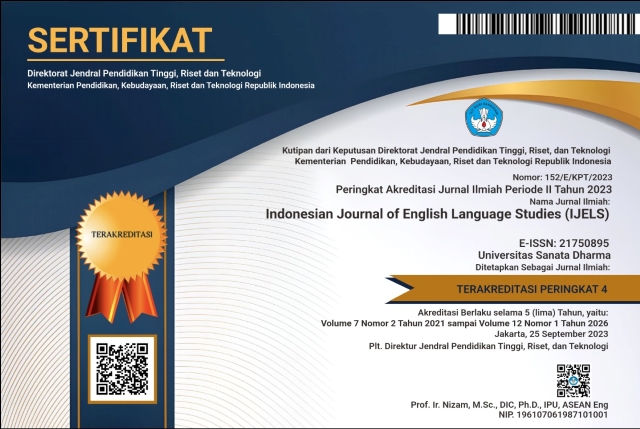Analysing Reading Comprehension of Primary School Students through Parenting Context
(1) Universitas Katolik Musi Charitas, Indonesia
(2) Universitas Katolik Musi Charitas, Indonesia
(*) Corresponding Author
Abstract
Keywords
Full Text:
PDFReferences
Altunkaya, H. (2016). Yabanci dil olarak türkçe öğrenenlere yönelik okuduğunu anlama başari testinin geliştirilmesi. TURKISH STUDIES-International Periodical for the Languages, Literature and History of Turkish or Turkic, 11(3), 113-138. http://dx.doi.org/10.7827/TurkishStudies.9324
Anastasiou, D. & Griva, E. (2009). Awareness of reading strategy use and reading comprehension among poor and good readers. Elementary Education Online, 8, 283-297. Retrieved from https://dergipark.org.tr/en/pub/ilkonline/issue/8598/107014
Ateş, M. (2008). İlköğretim ikinci kademe öğrencilerinin okuduğunu anlama düzeyleri ile Türkçe dersine karşı tutumları ve akademik başarıları arasındaki ilişki. Yayımlanmamış Doktora Tezi, Selçuk Üniversitesi, Sosyal Bilimler Enstitüsü, Konya. Retrieved from http://hdl.handle.net/123456789/9091
Barret, T.C. (1974). Taxonomy of reading comprehension. In R. C. Smith & T. C. Barrett (Eds.), Teaching reading in the middle grades (pp. 105-109). Reading, MA: Addison-Wesley.
Bustang, Zulkardi, Darmawijoyo, Dolk, M., & Van Erde, D. (2013). Developing a local instruction theory for learning the concept of angle through visual field activities and spatial representations. International Education Studies, 6(8), 58-70. https://doi.org/10.5539/ies.v6n8p58
Can, D. (2020). The mediator effect of reading comprehension in the relationship between logical reasoning and word problem solving. Participatory Educational Research (PER), 7(3), 230-246. Retrieved from https://eric.ed.gov/?id=EJ1269039
Clarke, D. M. (1997). The changing role of the mathematics teacher. Journal for Research in Mathematics Education, 28(3), 278-308. http://doi.org/10.2307/749782
Eskey, D. E. (2005). Reading in a second language. In E. Hinkel (Ed.), Handbook of research in second language teaching and learning (pp. 563-581). Mahwah, NJ: Lawrence Erlbaum Associates.
Fauziah, A., Putri R.I.I., Zulkardi, & Somakim. (2019). The roster context in angle learning for primary school preservice teacher. Journal of Physics: Conference Series, 1188(1), 012058. https://doi.org/10.1088/1742-6596/1188/1/012058.
Fox, E., & Alexander, P.A. (2011). Learning to read. In R.E. Mayer, & P.A. Alexander (Eds.), Handbook of research on learning and instruction (pp. 7-31). New York: Routledge.
Gilakjani, A.P. & Sabouri, N.B. (2016). How can students improve their reading comprehension skill? Journal of Studies in Education, 6(2), 229-240. https://doi.org/10.5296/jse.v6i2.9201
Gravemeijer, K. (1994). Developping Realistic Mathematics Education. Utrech: CD-â Press/ Freudenthal Institute.
Gravemeijer, K. (1999). How emergent models may foster the constitution of formal mathematics. Mathematical Thinking and Learning, 1(2), 155-177. https://doi.org/10.1207/s15327833mtl0102_4
Haris, D., & Putri, R.I.I. (2011). The role of context in third grader’s learning of area measurement. Journal Mathematics Education, 2(1), 55-66. https://doi.org/10.22342/jme.2.1.778.55-66.
Hewi, L., & Shaleh, M. (2020). Refleksi hasil PISA (The Programme For International Student Assesment): Upaya perbaikan bertumpu pada pendidikan anak usia dini). Jurnal Golden Age, 4(1), 30-41. https://doi.org/10.29408/goldenage.v4i01.2018
Inharjanto, A., & Lisnani. (2020). Developing coloring books to enhance reading comprehension competence and creativity. Advances in Social Science, Education and Humanities Research: Proceedings of the 3rd International Conference on Innovative Research Across Disciplines (ICIRAD 2019), 7-12. https://doi.org/10.2991/assehr.k.200115.002
Inharjanto, A., & Lisnani. (2021). ELT learning media for young learners: Family-themed picture stories. Indonesian EFL Journal (IEFLJ), 7(1), 21-32. https://doi.org/10.25134/ieflj.v7i1.3987
Kintsch, W. (2004). The construction-integration model of text comprehension and its implications for instruction. In R. B. Ruddell & N. J. Unrau (Eds.), Theoretical models and processes of reading (pp.1270–1328). Newark, DE: International Reading Association.
Klingner, J. K., Vaughn, S., & Boardman, A. (2007). Teaching reading comprehension to students with learning difficulties. New York: The Guilford Press.
Liao, G. (2011). On the development of reading ability. Theory and Practice in Language Studies, 1(3), 302-305. https://doi.org/10.4304/tpls.1.3.302-305
National Reading Panel. (2000). Teaching children to read: An evidence-based assessment of the scientific research literature on reading and its implications for reading instruction. Washington, DC: U. S. Department of Health and Human Services, National Institute of Child Health and Human Development.
Oakley, G. (2011). The assessment of reading comprehension cognitive strategies: Practices and perceptions of Western Australian teachers. Australian Journal of Language and Literacy, 34, 279-292. https://doi.org/10.1007/BF03651863
Onwuegbuzie, A.J., Mayes, E., Arthur, L., Johnson, J., Robinson, V., Ashe, S., Elbedour, S. & Collins, K.M.T. (2004). Reading comprehension among African American graduate students. The Journal of Negro Education, 73(4), 443- 457. https://doi.org/10.2307/4129628
Özdemir, E.C., & Akyol, H. (2019). The development of a reading comprehension test. Universal Journal of Educational Research, 7(2), 563-570. https://doi.org/10.13189/ujer.2019.070229
Pardo, L. S. (2004), What every teacher needs to know about reading comprehension. The Reading Teacher, 58(3), 272-280. https://doi.org/10.1598/RT.58.3.5
Risdiyanti, I., Prahmana, R.C.I., & Shahrill, M. (2019). The learning trajectory of social arithmetic using an Indonesian traditional game. Elementary Education Online, 18(4), 2094-2108. https://doi.org/10.17051/ilkonline.2019.639439.
Salim & Haidir (2019). Penelitian pendidikan metode, pendekatan, dan jenis. Jakarta: Kencana
Sukmadinata, N. S. (2016). Metode penelitian pendidikan. Bandung: PT Remaja Rosdakarya.
The RAND Reading Study Group. (2002). Reading for understanding: Toward a research and development program in reading comprehension. Santa Monica, CA: Office of Education Research and Improvement.
Van den Heuvel & Panhuizen, M. (2000). Mathematics education in Netherland: A guided tour Freudenthal Institute CD-room for ICME9. Utrecht: Utrecht University.
Widjaya, W., Dolk, M., & Fauzan, A. (2010). The role of context and teacher’s questioning to enhance students’ thinking. Journal of Science and Mathematics Education in Southeast Asia, 33(2), 168-186. http://hdl.handle.net/10536/DRO/DU:30048397.
Zulkardi. (2002). Developing a learning environment on realistic mathematics education for Indonesian teachers. Dissertation. Enschede: University of Twente.
DOI: https://doi.org/10.24071/ijels.v9i1.5650
Refbacks
- There are currently no refbacks.

This work is licensed under a Creative Commons Attribution-ShareAlike 4.0 International License.
IJELS Journal Sinta 4 Certificate (S4 = Level 4)
We would like to inform you that Indonesian Journal of English Language Studies (IJELS) has been nationally accredited Sinta 4 by the Ministry of Education, Culture, Research and Technology of the Republic of Indonesia based on the decree No. Surat Keputusan 152/E/KPT/2023. Validity for 5 years: Vol 7 No 2, 2021 till Vol 12 No 1, 2026

This work is licensed under CC BY-SA.
Creative Commons Attribution-ShareAlike 4.0 International License
IJELS e-ISSN 2715-0895; IJELS p-ISSN 2442-790X
Indonesian Journal of English Language Studies (IJELS) is published twice a year, namely in March and September, by the English Language Studies (ELS) of the Graduate Program of Sanata Dharma University, Yogyakarta, Indonesia.


 IJELS p-ISSN:
IJELS p-ISSN: 









